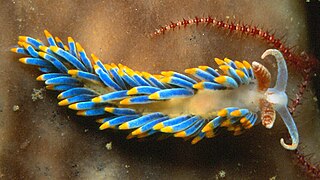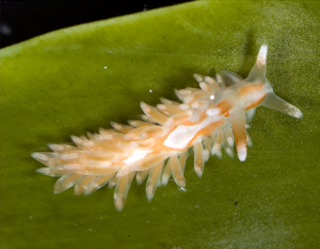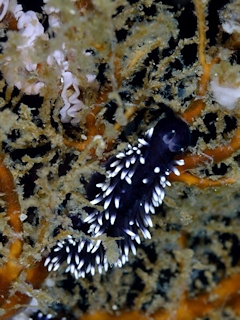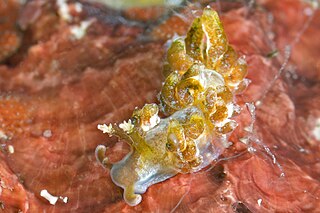
The purple lady nudibranch, Paraflabellina funeka, is a species of aeolid nudibranch, and is a very colourful sea slug. It is a marine gastropod mollusc in the family Flabellinidae.

The white-edged nudibranch, Coryphella capensis, previously known as Fjordia capensis, is a species of sea slug, specifically an aeolid nudibranch, a colourful sea slug. It is a marine gastropod mollusc in the family Coryphellidae.

Flabellina is a genus of sea slugs, specifically aeolid nudibranchs. These animals are marine gastropod molluscs in the family Flabellinidae.
The black-dot nudibranch, Caloria sp. 1, as designated by Gosliner, 1987, is a species of sea slug, specifically an aeolid nudibranch. They are marine gastropod molluscs in the family Facelinidae.

Cratena capensis, the orange-eyed nudibranch, is a species of sea slug, specifically an aeolid nudibranch. It is a marine gastropod mollusc in the family Facelinidae.

Berghia is a genus of sea slugs, aeolid nudibranchs. They are shell-less marine gastropod molluscs in the family Aeolidiidae. They are covered in cerata which give them their unique tentacle look and color. Berghia are commonly found in shallow waters and their diet consists of strictly Aiptasia Anemone. This genus is now commonly used commercially to fight off Anemone populations in fish tanks.

Piseinotecus is a genus of sea slugs, aeolid nudibranchs, marine gastropod mollusks in the family Piseinotecidae.

Calmella is a genus of sea slugs, aeolid nudibranchs, marine gastropod mollusks in the family Flabellinidae.

Piseinotecus soussi is a species of sea slug, an aeolid nudibranch, a marine gastropod mollusc in the family Piseinotecidae.
Piseinotecus kima is a species of sea slug, an aeolid nudibranch, a marine gastropod mollusk in the family Piseinotecidae.
Anteaeolidiella saldanhensis, is a species of sea slug, an aeolid nudibranch. It is a shell-less marine gastropod mollusc in the family Aeolidiidae.
Anteaeolidiella ireneae is a species of sea slugs, an aeolid nudibranch. It is a marine gastropod mollusc in the family Aeolidiidae.
Anteaeolidiella poshitra is a species of sea slugs, an aeolid nudibranch. It is a marine gastropod mollusc in the family Aeolidiidae.

Anteaeolidiella lurana, is a species of sea slug, an aeolid nudibranch. It is a marine gastropod mollusc in the family Aeolidiidae.

Spurilla neapolitana, the Neapolitan spurilla, is a species of sea slug, an aeolid nudibranch, a marine gastropod mollusk in the family Aeolidiidae. It is native to the western Atlantic Ocean, the Caribbean Sea and the Mediterranean Sea. This species was first described as Eolis neapolitana by the Italian naturalist Stefano delle Chiaje in 1841. However, although some authorities quote the year as 1823, the species does not appear in the first volume of delle Chiaje's memoirs, which was published that year. The species was later reassigned to the genus Spurilla.
Baeolidia lunaris is a species of sea slug, an aeolid nudibranch. It is a marine gastropod mollusc in the family Aeolidiidae found in Tanzania.
Algarvia alba is a species of sea slug, specifically an aeolid nudibranch. It is a marine gastropod mollusc in the family Facelinidae.
Edmundsella albomaculata is a species of sea slug, an aeolid nudibranch, a marine gastropod mollusc in the family Flabellinidae.

Protaeolidiella atra is a species of sea slug, an aeolid nudibranch, a marine gastropod mollusc in the family Pleurolidiidae.

Baeolidia variabilis is a species of sea slug, an aeolid nudibranch. It is a marine gastropod mollusc in the family Aeolidiidae found in the Philippines, the Marshall Islands and Papua New Guinea, central Indo-Pacific Ocean.











